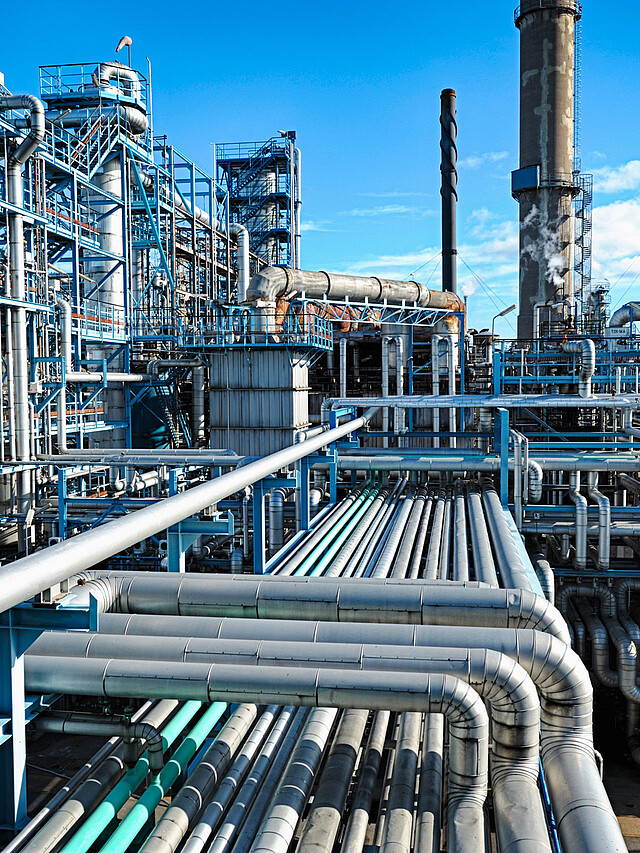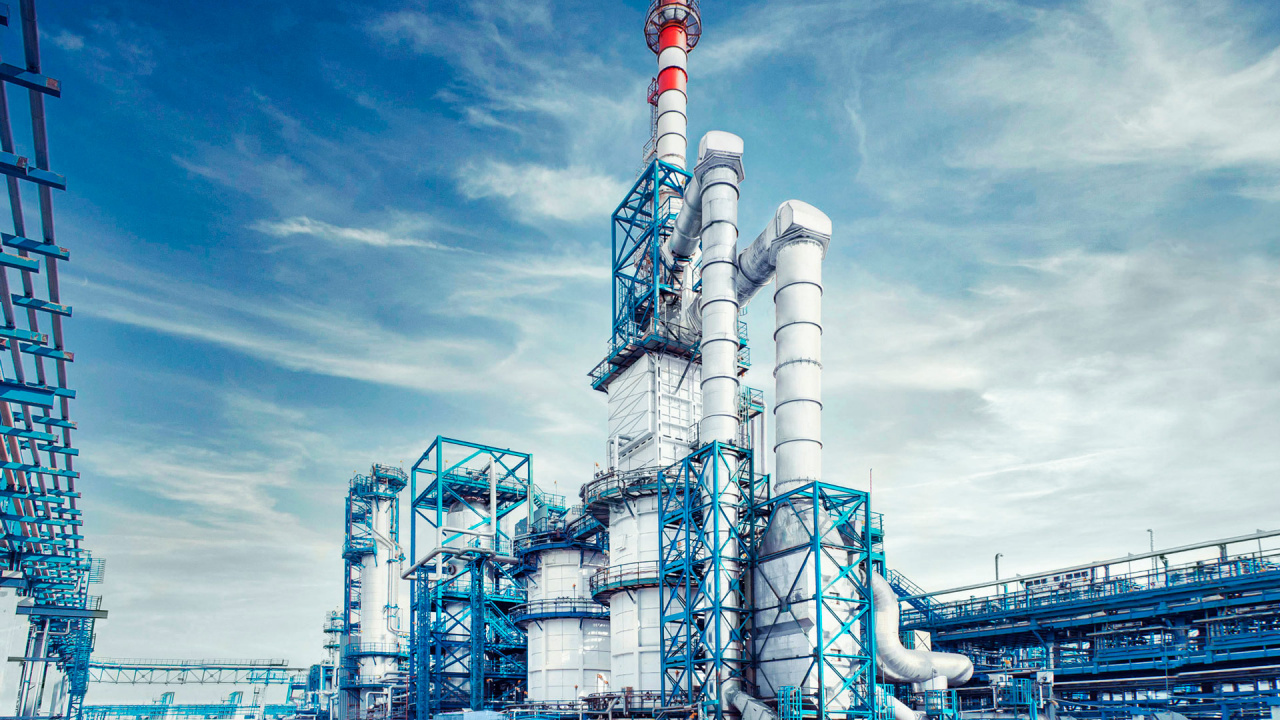PARNASA – FZCO is ready to supply the customer, at his request, with various equipment for oil and gas production, petrochemical plants, as well as installations for chemical gas processing
Equipment

for example:
Gas cleaning and deep drying plants
A standard installation for adsorption gas drying makes it possible to absorb water molecules by the surface of the pores of a solid adsorbent, followed by their removal from the pores by external influences (an increase in the temperature of the adsorbent or a decrease in the pressure of the medium).
Drying of gas with solid desiccants is carried out in batch apparatuses with a fixed desiccant bed. The complete cycle of the drying process consists of the stages of adsorption, regeneration and cooling of the adsorbent. Silica gels, aluminosilica gels, activated alumina, bauxites and molecular sieves (zeolites) are used as desiccants. Their adsorption capacity essentially depends on the size of the pores and, accordingly, the specific surface of the latter. A feature of molecular sieves is the ability to absorb not only moisture, but also hydrogen sulfide and carbon dioxide, i.e. clean gas from acidic components. To reduce the resistance to gas movement, adsorbents are made in the form of balls or granules. The requirements for the dryer are very stringent: it must quickly absorb moisture from the gas and be easily regenerated, withstand multiple regenerations without significant loss of activity and strength, have high mechanical strength and absorption capacity, show little resistance to gas flow, and have a low cost. Sometimes a combination of two dryers in one apparatus is used, for example, silica gel and activated alumina, which makes it possible to combine the high absorption capacity of silica gel with a high degree of gas drying with aluminum oxide. Heated gas is used to regenerate the dryer. The desorption temperature is usually 160-180°C (for molecular sieves – 280-290°C).
The adsorption dryingplant
consists of at least two adsorption units.
Wet gas, having passed through the droplet separator, enters one of the adsorbers from above and passes through it. Another adsorber at this time is at the stage of regeneration or cooling. The dried gas is fed to further processing or to a gas pipeline. Part of the initial gas, having passed through the tubular heater, is sent to the bottom of another adsorber for the regeneration of the dryer. The gas from the regeneration passes through a heat exchanger for cooling, a separator for separating water and mixes with the main stream of moist gas.
The full cycle of operation of one apparatus includes the following four periods:
- adsorption at a temperature of 35 – 50°C, a pressure of 8-12 MPa, the duration of contact of the gas with the adsorbent for at least 10 s (gas velocity in the apparatus 0.15 – 0.30 m/s). The duration of adsorption is chosen based on the adsorption capacity of the absorber, the initial and final humidity of the gas, the load of the adsorbent in the apparatus;
- heating of the adsorbent, which is carried out after switching the apparatus from adsorption to desorption mode. Heating is carried out with hot gas from a tubular heater at a rate of not more than 60°C per hour. The time spent on heating is 0.6 -0.65 of the adsorption period;
- desorption – displacement of absorbed water from the pores of the adsorbent and restoration of its adsorption activity. It begins to occur when the temperature of the adsorbent reaches 200-250°C (for silica gels) or 300-350°C (for zeolites). Hot gas during the periods of heating and desorption passes through the adsorbent layer in the direction opposite to the direction of the dried gas during the adsorption period (i.e., from bottom to top);
- cooling of the adsorbent, it starts after the completion of desorption and switching the device to the adsorption (drying) mode. Cooling is carried out with the initial cold gas. The cooling period takes 0.35 – 0.40 of the time spent on adsorption.
During adsorption drying, the presence of hydrocarbons from butanes and above in the gas complicates the process, because these hydrocarbons are absorbed in the adsorption stage at the outlet part of the adsorbent layer and, when water is desorbed at high temperature, tend to form coke deposits in the pores of the adsorbent. Gradual coking of the adsorbent leads to a decrease in its adsorption capacity; therefore, it is required to periodically regenerate the adsorbent, i.e., burn coke out of its pores.
When drying gases containing acidic components, zeolites are the most reliable in operation.
A distinctive feature of the adsorption drying method in comparison with the absorption method is a high degree of gas drying, regardless of its parameters, the compactness of the installation, and low capital costs for low-capacity installations. The disadvantages of the method are high costs for the adsorbent, high resistance to gas flow and high costs in the construction of high-capacity plants.
The development of the adsorption method goes in the direction of the development of short-cycle processes for drying gases. The duration of adsorption and desorption cycles is 1.5-10 hours, and adsorption is carried out at elevated pressure and ambient temperature, and desorption is carried out at atmospheric pressure and the same temperature. The advantage of short cycle adsorption is to increase productivity and the possibility of complete automation of the process.
Adsorption drying makes it possible to achieve dew point depression up to 100°С (dew point down to minus 90°С). Therefore, this method is used when a high drying depth is required. Purified natural gas, sent, for example, to a helium plant, must be subjected to adsorption drying on zeolites, since strict requirements are imposed on the raw materials of low-temperature processing plants in terms of moisture content (the dew point should not be higher than minus 70 ° C).
GPP gas processing plant
This is a complex of facilities that provide commercial products (LNG) and other components from natural gas.
The main facilities of the GPP:
- point of reception and preparation of raw materials;
- compressor stations (CS);
- technological installations (cleaning, stripping and drying of gas, separation of ethane, propane, butane and pentane, sulfur production, stabilization and processing of gas condensate);
- LNG production lines;
- storage tanks;
- equipment for loading onto gas tankers;
- additional services to provide the plant with electricity and water for cooling.
The raw material can be:
- natural gas;
- associated petroleum gas (APG);
- gas condensate.

GPP products:
- individual hydrocarbons and their mixtures,
- related products (sulphur, helium),
- natural gas motor fuel (NGF).
Technological operations of the GPP:
- gas separation, deep drying and recovery of light hydrocarbons by low-temperature condensation and rectification (LTC),
- production of helium and ethane by fractionated gas condensation during its deep cooling,
- absorption purification of gas from acidic components with amine solutions,
- adsorption purification of gas from mercaptans by zeolites, low-temperature oil absorption and low-temperature condensation.
Gas stripping plants
Gas stripping units are designed to extract heavy hydrocarbons from gas. They are based on the following methods for the extraction of heavy hydrocarbons:
- oil absorption
- low temperature separation
- low temperature condensation.
Absorption extraction is a well-known process for a long time; diesel and kerosene fractions are most often the absorbent.
The process of gas stripping at the plant is as follows:
the gas entering the plant is cooled in coolers and enters the separator, after which it is sent to the absorber, in which the main part of heavy hydrocarbons is separated from the gas. The absorbent saturated with hydrocarbons enters the central part of the stripping column, and the liquid phase from the separator enters the same column below. The regenerated absorbent is fed from above the stripping column. During the process, light hydrocarbons (methane, ethane) are removed from the absorbent going down the column and hydrocarbons from propane and above are absorbed by the absorbent. Fully saturated absorbent from the lower part of the column enters the heat exchanger, where it is heated and fed into the desorber for distillation of a wide fraction of light hydrocarbons, after which the regenerated absorbent is fed back into the absorber and the technological cycle is repeated.
Low-temperature separation – consists in the condensation of hydrocarbons when the gas temperature drops to -30 degrees, due to its throttling through a special valve or gas expansion in a turboexpander, in order to appropriately use the pressure drop. The degree of condensation of each individual hydrocarbon depends on the temperature and pressure in the process.
At a temperature of about -40°C, almost complete condensation of butanes and pentanes occurs.
Similar condensation of ethanes and propanes requires lower temperatures.
Due to the low temperatures of the low-temperature separation process, an inhibitor (methanol, glycols) is introduced into the gas to prevent the formation of hydrates
hydrates* – solid flocculent complex compounds of light hydrocarbons with water
The danger of hydrate formation lies in their damage (clogging) of instrumentation, fittings and communications.
The expediency of using the process of low-temperature separation for the extraction of hydrocarbons from gas is determined mainly by the composition of the source gas.
One of the main disadvantages of the low-temperature separation process, despite its technological simplicity, is that in order to maintain the desired level of extraction of liquid hydrocarbons from an increasingly lighter gas as the reservoir pressure decreases due to field development, it is necessary to constantly reduce the temperature of the process and increase the pressure.
In cases when the field is developed in order and the natural reservoir pressure is no longer high, the company’s specialists use technology in their gas stripping units – based on the low-temperature condensation process.
One of the main disadvantages of the low-temperature separation process, despite its technological simplicity, is that in order to maintain the desired level of extraction of liquid hydrocarbons from an increasingly lighter gas as the reservoir pressure decreases due to field development, it is necessary to constantly reduce the temperature of the process and increase the pressure.
In cases when the field is developed in order and the natural reservoir pressure is no longer high, the company’s specialists use technology in their gas stripping units – based on the low-temperature condensation process.
Low temperature condensation – this process is carried out at lower temperatures than low temperature separation and allows you to extract ethane and heavier hydrocarbons from the gas.
In the hardware design of this process, along with the throttling effect, artificial cooling with propane cold or a cascade refrigeration propane-ethane cycle is also used. Thanks to this, it is possible to extract up to 90% of ethane, 99% of propane and 100% of all other hydrocarbons from gas.
In the proposed installations for creating artificial cold, turboexpanders are most often used, in which the energy of the expanding gas is recovered to create cold, or compressor refrigeration machines, refrigerants, in which freon, ethane, propane are usually used.
The hardware design of a standard gas stripping unit based on the low-temperature condensation process is the following technological complex:
The pre-dried gas is cooled in recuperative heat exchangers, after which it enters the separator, where condensed hydrocarbons are separated from it, after which it goes to a turbo expander, from which it is fed to the separation column. It also receives a mixture of condensed hydrocarbons from the separator from the heat exchangers. At the bottom of the column, a mixture of condensed hydrocarbons is taken from ethane and above, and the deethanized gas is discharged from the top of the column to heat exchangers, after which it enters the turbo expander, in which it is compressed due to the energy of the expanding gas from the separator and is sent further to the customer. The mixture of produced hydrocarbons is sent to a gas fractionation plant, where 90% ethane fraction and fractions of other heavier hydrocarbons are taken from it.
Isobutane plant
The raw materials for the production of isobutane are gas gasolines obtained from natural and refinery gases, oil stabilization products, pyrolysis and cracking gases. The separation of a mixture of light hydrocarbons into individual commercially pure substances occurs in gas fractionation plants.
The scheme for separating gas gasoline in a gas fractionation plant includes its preheating in a heat exchanger and feeding it into a propane column. Propane vapor is discharged from the top of the column, which condenses in a condenser-refrigerator and enters the irrigation tank. Part of the propane is returned to the column, and the excess is discharged as a finished product. The liquid from the bottom of the column after heating enters the next column for further separation according to the same scheme, where a mixture of butanes and gasoline are separated from it. Similarly, a mixture of butanes is separated into isobutane and normal butane, and gasoline is separated into isopentane, normal pentane, hexane and other components.
The purity of the isobutane thus obtained is approximately 95%. For use as a refrigerant, additional purification of the substance is required.
Isobutane is a fairly popular product. To meet the needs of industry, in addition to straight-run isobutane, isobutane is used, obtained by isomerization of normal butane (n-butane).
Polypropylene production plant
The unit is designed to produce polypropylene used in radio engineering, chemical, medical, and food industries.
The polypropylene production unit consists of the following blocks:
– block for fine purification of propylene, designed to remove organic and inorganic compounds of sulfur, water and oxygen harmful for polymerization from the propylene fraction;
– propylene storage unit, designed to create a supply of purified propylene;
– propylene polymerization block, designed to produce polypropylene of the required quality;
– propylene recovery unit, designed to separate propylene from its mixture with nitrogen after flash evaporators and return to the process;
– a block for the preparation of a catalyst, activator, DDS for the reaction.
The plant produces isotactic form polypropylene. The raw material for the production of polypropylene is the propylene fraction obtained at the gas fractionation unit from the propane-propylene fraction. For the polymerization process, a catalyst, an activator, technical hydrogen, auxiliary reagents (DDS) are also used.

